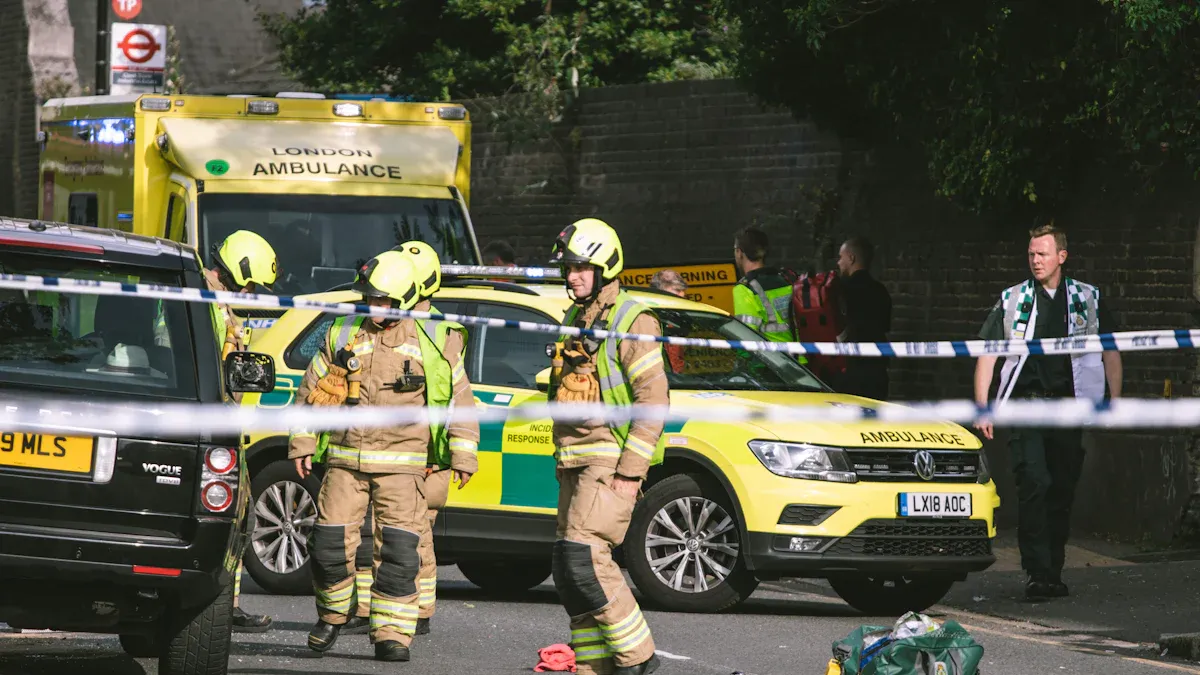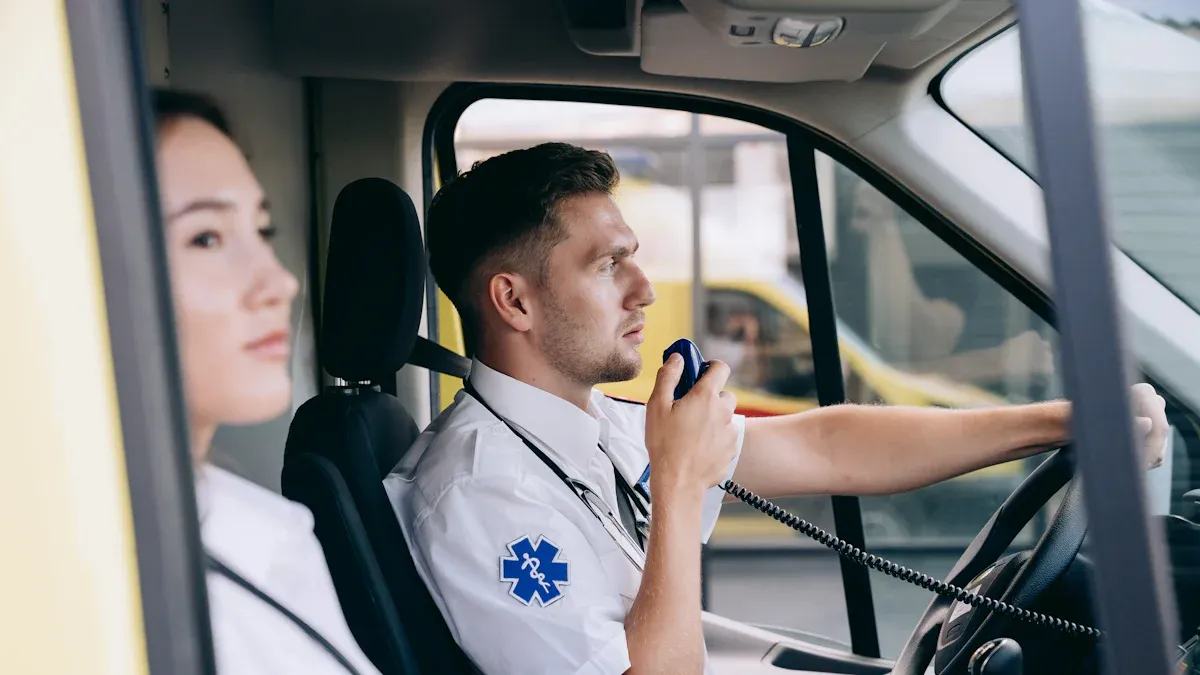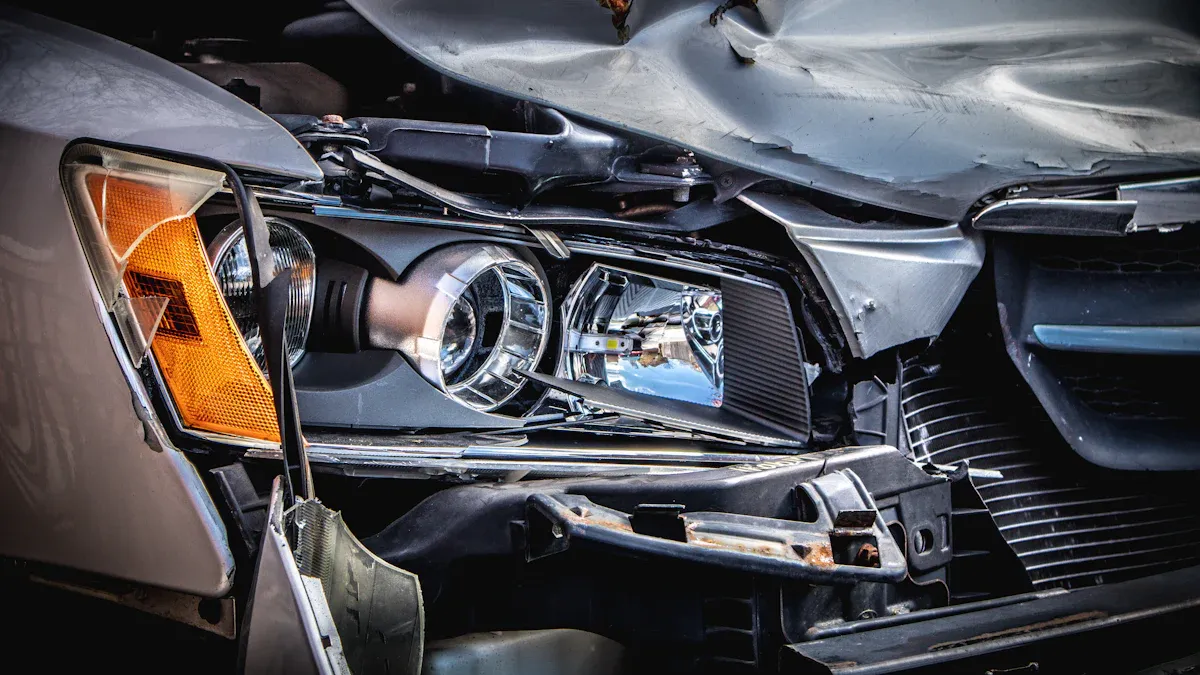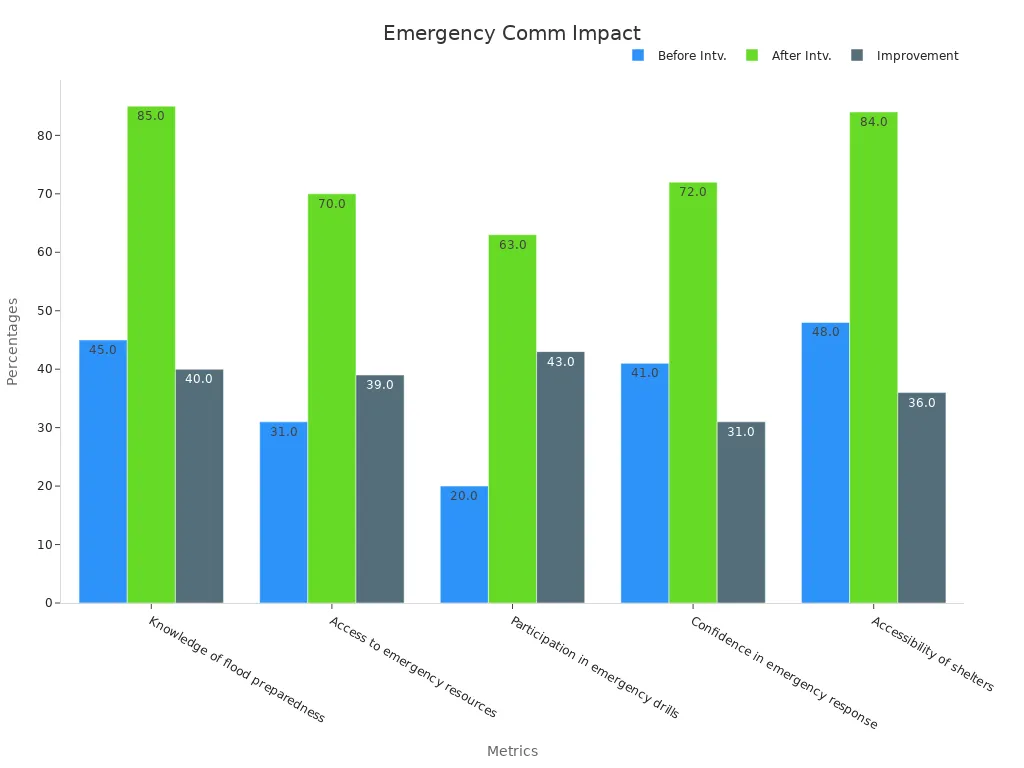
Road accidents often create chaotic and stressful situations, making effective communication with emergency services crucial. Knowing how to use tools like a traffic emergency telephone or a rugged emergency telephone can save lives. Additionally, having an auto dial emergency telephone can streamline the process of reaching out for help. Clear and calm communication reduces anxiety and ensures vital information is conveyed. Studies show that response times significantly affect survival rates, especially during rush hour. Keeping a composed demeanor helps dispatchers guide callers and provide reassurance, improving outcomes for everyone involved, particularly when using an industrial heavy duty telephone designed for such critical situations.
Prioritize Immediate Safety

Pull Over to a Safe Location
Ensuring safety begins with moving vehicles away from active traffic lanes. Drivers should pull over to a secure spot, such as the shoulder of the road or a designated emergency area. This action minimizes the risk of secondary collisions. According to recent data, advanced monitoring systems can autonomously pull over vehicles if drivers are incapacitated, potentially saving lives. Additionally, drowsy driving contributes to 9.5% of crashes, highlighting the importance of stopping when unwell. Drivers using a traffic emergency telephone should ensure they are in a safe location before making the call.
| Safety Measure | Benefit |
|---|---|
| Autonomous vehicle pull-over technology | Prevents crashes caused by incapacitated drivers |
| Stopping when feeling unwell | Reduces accidents linked to medical emergencies |
Turn on Hazard Lights
Activating hazard lights alerts other drivers to the presence of a stationary vehicle. This simple step can prevent further accidents. Studies reveal that nearly one-third of collisions involve stationary vehicles, even when hazard lights are on. Improving the visibility of these lights could significantly reduce such incidents. Drivers should ensure their hazard lights are functioning properly to enhance safety during emergencies.
Assess the Situation and Check for Injuries
After securing the vehicle, assessing injuries is critical. Research shows that prompt evaluation, such as using the Glasgow Coma Scale (GCS), improves survival rates. Victims with low GCS scores face higher mortality risks, emphasizing the need for immediate attention. Low blood pressure and oxygen saturation also predict outcomes, making quick assessments vital. Drivers should check themselves and others for visible injuries and report this information when contacting emergency services.
Using a Traffic Emergency Telephone or Mobile Device

Dial the Correct Emergency Number
Contacting emergency services begins with dialing the appropriate number for the region. In the United States, 911 is the standard emergency number, while other countries may use different codes, such as 112 in Europe. Using a traffic emergency telephone simplifies this process, as these devices are often pre-programmed to connect directly to emergency dispatchers.
Tip: Save local emergency numbers in your mobile device before traveling to unfamiliar areas. This ensures quick access during critical situations.
Studies show that geolocation-enabled mobile applications significantly reduce response times by providing instant location data. Calls made through such apps decrease delays caused by manual location reporting, which can be life-saving during severe accidents.
Provide Your Exact Location
Accurate location information is vital for emergency responders. Drivers should use landmarks, mile markers, or GPS coordinates to describe their position. A traffic emergency telephone often includes location identifiers, making it easier for dispatchers to pinpoint the incident site.
| Benefit | Impact on Response Times |
|---|---|
| Swift arrival of medical personnel | Can make a life-or-death difference during critical incidents |
| Optimal resource allocation | Ensures the closest units are dispatched quickly |
| Efficient route planning | Helps avoid obstacles and traffic delays |
| Coordination of responders | Enhances teamwork and response speed |
Emergency services rely on precise location data to plan routes and allocate resources effectively. Regular updates to location databases further improve response efficiency, ensuring timely assistance.
Describe the Nature of the Incident
Dispatchers need a clear understanding of the situation to send appropriate help. Drivers should briefly explain what happened, such as a collision, vehicle rollover, or pedestrian injury. Using concise language ensures dispatchers can categorize the incident accurately.
Researchers have demonstrated that detailed incident descriptions improve emergency dispatch efficiency. Categorizing incidents correctly allows responders to prioritize cases and allocate resources effectively. For example, a rollover may require specialized equipment, while a minor collision may only need basic medical assistance.
Note: Avoid exaggerating or downplaying the severity of the situation. Stick to factual details to ensure the right type of help is dispatched.
Share Details About Vehicles and Injuries
Providing information about the vehicles involved and the injuries sustained helps responders prepare for the situation. Drivers should mention the number of vehicles, their types (e.g., sedan, truck, motorcycle), and any visible damage. Injuries should be described clearly, including whether individuals are conscious, bleeding, or trapped.
| Evidence Description | Details |
|---|---|
| Incident Categorization | Researchers manually coded 3,564 unique incident descriptions to ensure accurate categorization, which is crucial for effective emergency dispatch. |
| Collaborative Approach | Four researchers worked in teams to discuss and adjudicate discrepancies in categorization, enhancing reliability and validity. |
| Performance Evaluation | Machine learning models were used to analyze misclassifications, ensuring that the categorization process was robust and effective. |
Dispatchers use this information to determine the urgency of the situation and the type of assistance required. For example, a trapped individual may necessitate fire department intervention, while minor injuries may only require paramedics.
Communicating Effectively with Dispatchers
Stay Calm and Focused
Remaining calm during an emergency call is essential for effective communication. Stress can impair clarity, making it harder for dispatchers to understand the situation. Studies show that improved communication reduces stress levels by 9.45% and lowers burnout rates by nearly 19%. Drivers should take a deep breath before speaking and focus on providing accurate information. Staying composed allows dispatchers to guide the caller efficiently, ensuring a faster response.
Tip: If feeling overwhelmed, pause briefly to collect your thoughts before continuing the conversation. This small step can significantly improve communication clarity.
Speak Clearly and Concisely
Clear and concise language minimizes misunderstandings during emergency calls. Dispatchers rely on precise information to assess the situation and deploy appropriate resources. Research highlights that using plain language enhances public understanding and reduces confusion. Callers should avoid using jargon or overly detailed explanations. Instead, they should stick to simple descriptions, such as "two cars collided" or "a person is unconscious."
- Key Recommendations for Effective Communication:
- Use short sentences to describe the incident.
- Avoid unnecessary details that may distract from critical facts.
- Speak at a steady pace to ensure dispatchers can follow the information.
This approach ensures that dispatchers can quickly categorize the incident and provide the necessary assistance.
Follow Dispatcher Instructions
Following dispatcher instructions is critical for ensuring efficient emergency service delivery. Dispatchers are trained to guide callers through specific actions, such as performing CPR or moving to a safer location. Studies demonstrate that dispatcher-assisted programs, such as public-access defibrillation, significantly improve survival rates for cardiac arrest patients.
| Study Title | Findings |
|---|---|
| Effects of Dispatcher‐Assisted Public‐Access Defibrillation Programs on the Outcomes of Out‐of‐Hospital Cardiac Arrest | Dispatcher guidance increased bystander defibrillator use and improved survival rates. |
| Dispatchers trained in persuasive communication techniques improved the effectiveness of dispatcher-assisted cardiopulmonary resuscitation | Training dispatchers in communication skills enhanced survival rates, especially when callers were family members. |
Callers should listen carefully and follow instructions step by step. For example, if a dispatcher advises moving away from a traffic emergency telephone to a safer location, the caller should comply immediately. This cooperation ensures that responders can act effectively upon arrival.
Be Ready to Answer Follow-Up Questions
Dispatchers may ask follow-up questions to clarify details or gather additional information. These questions help them assess the severity of the situation and determine the best course of action. Callers should remain patient and answer each question to the best of their ability.
- Examples of Common Follow-Up Questions:
- "How many people are injured?"
- "Are any vehicles leaking fuel?"
- "Is anyone trapped inside a vehicle?"
Providing accurate answers helps dispatchers allocate resources efficiently. For instance, if a caller reports that someone is trapped, the dispatcher may send a fire rescue team equipped with specialized tools. Cooperation during this phase ensures that emergency services arrive prepared to handle the situation.
Note: If unsure about a question, it is better to admit uncertainty than to provide incorrect information. Dispatchers can work with limited details if necessary.
Special Situations to Consider
Limited Cell Service: What to Do
When cell service is limited, alternative communication methods become essential for contacting emergency services. Mobile phone data, such as Call Detail Records (CDRs), can provide critical information like location and call duration. Emergency responders often combine this data with satellite imagery to model human mobility and assess infrastructure impacts during crises.
- Alternative Communication Methods:
- Ham radios offer reliable long-distance communication during emergencies.
- CB radios can transmit over extended ranges under favorable conditions.
- GMRS radios allow the use of repeaters to enhance range, provided permission is obtained.
These tools ensure that individuals can relay vital information even when traditional networks fail. Preparing for emergencies by learning how to use these devices can significantly improve response times and outcomes.
Assisting Someone with Disabilities
Emergency situations require tailored strategies to assist individuals with disabilities effectively. Specialized programs, such as safety assessment initiatives, have proven to enhance preparedness and accessibility.
| Metric | Before Intervention | After Intervention | Improvement |
|---|---|---|---|
| Knowledge of flood preparedness | 45.0% | 85.0% | +40.0% |
| Access to emergency resources | 31.0% | 70.0% | +39.0% |
| Participation in emergency drills | 20.0% | 63.0% | +43.0% |
| Confidence in emergency response | 41.0% | 72.0% | +31.0% |
| Accessibility of shelters | 48.0% | 84.0% | +36.0% |
Tailored communication strategies, such as visual aids and simplified instructions, can further improve emergency response for individuals with disabilities. These measures ensure inclusivity and enhance safety during critical incidents.

Handling Language Barriers
Language barriers can complicate emergency communication, but innovative solutions have shown promising results. Apps developed collaboratively with paramedics and software designers improve communication with non-fluent English speakers.
- Key Findings:
- Call takers often miss critical information from non-fluent English callers, delaying recognition of life-threatening conditions.
- Emergency dispatch centers should implement strategies to address language discordance, such as multilingual training or translation services.
| Findings | Recommendations |
|---|---|
| Call takers often miss critical information from non-fluent English callers, leading to delays in recognizing cardiac arrest. | Emergency medical dispatch centers should implement strategies to better handle calls from non-fluent English speakers to improve recognition of critical conditions. |
These measures ensure that language barriers do not hinder emergency response, enabling faster and more accurate assistance.
Reporting an Accident as a Witness
Witness-reported information plays a crucial role in improving emergency response times. During the 2016 Taiwan earthquake, social media reports from witnesses enabled emergency responders to act within minutes.
- Benefits of Witness Reports:
- EMTs shared critical information, facilitating the establishment of a temporary Emergency Response Center.
- Precise details provided by witnesses allowed the incident command system to respond efficiently.
Witnesses should focus on providing clear and accurate information, such as the location, nature of the incident, and visible injuries. Their input can significantly enhance the coordination and effectiveness of emergency services.
Staying safe and communicating effectively during road accidents can save lives. Drivers should prioritize safety by moving to secure locations and using hazard lights. Clear communication with emergency services ensures timely assistance.
- Proper coordination with responders helps document critical details, aiding legal investigations and liability assessments.
- Effective safety communication prevents hazards and promotes understanding of emergency procedures.
Remaining calm and prepared allows individuals to handle emergencies with confidence and clarity.
FAQ
What should you do if you cannot find a traffic emergency telephone nearby?
Drivers should use their mobile devices to call emergency services. If cell service is unavailable, alternative tools like CB radios or GMRS radios can help.
How can witnesses assist during road accidents?
Witnesses should provide clear details about the incident, including location, injuries, and vehicle descriptions. Their input helps emergency responders act quickly and efficiently.
Are emergency numbers the same in every country?
No, emergency numbers vary by region. For example, 911 is used in the United States, while 112 is common in Europe. Save local numbers before traveling.


